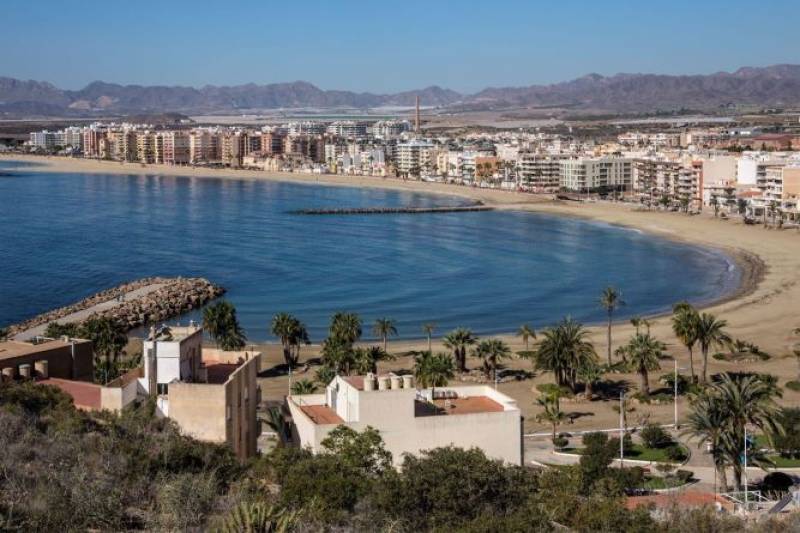- Region
- Águilas
- Alhama de Murcia
- Jumilla
- Lorca
- Los Alcázares
- Mazarrón
- San Javier
-
ALL AREAS & TOWNS
- AREAS
- SOUTH WEST
- MAR MENOR
- MURCIA CITY & CENTRAL
- NORTH & NORTH WEST
- TOWNS
- Abanilla
- Abarán
- Aguilas
- Alamillo
- Alcantarilla
- Aledo
- Alhama de Murcia
- Archena
- Balsicas
- Blanca
- Bolnuevo
- Bullas
- Cañadas del Romero
- Cabo de Palos
- Calasparra
- Camping Bolnuevo
- Campo De Ricote
- Camposol
- Canada De La Lena
- Caravaca de la Cruz
- Cartagena
- Cehegin
- Ceuti
- Cieza
- Condado de Alhama
- Corvera
- Costa Cálida
- Cuevas De Almanzora
- Cuevas de Reyllo
- El Carmoli
- El Mojon
- El Molino (Puerto Lumbreras)
- El Pareton / Cantareros
- El Raso
- El Valle Golf Resort
- Fortuna
- Fuente Alamo
- Hacienda del Alamo Golf Resort
- Hacienda Riquelme Golf Resort
- Isla Plana
- Islas Menores & Mar de Cristal
- Jumilla
- La Azohia
- La Charca
- La Manga Club
- La Manga del Mar Menor
- La Pinilla
- La Puebla
- La Torre
- La Torre Golf Resort
- La Unión
- Las Palas
- Las Ramblas
- Las Ramblas Golf
- Las Torres de Cotillas
- Leiva
- Librilla
- Lo Pagan
- Lo Santiago
- Lorca
- Lorquí
- Los Alcázares
- Los Balcones
- Los Belones
- Los Canovas
- Los Nietos
- Los Perez (Tallante)
- Los Urrutias
- Los Ventorrillos
- Mar De Cristal
- Mar Menor
- Mar Menor Golf Resort
- Mazarrón
- Mazarrón Country Club
- Molina de Segura
- Moratalla
- Mula
- Murcia City
- Murcia Property
- Pareton
- Peraleja Golf Resort
- Perin
- Pilar de la Horadada
- Pinar de Campoverde
- Pinoso
- Playa Honda
- Playa Honda / Playa Paraíso
- Pliego
- Portmán
- Pozo Estrecho
- Puerto de Mazarrón
- Puerto Lumbreras
- Puntas De Calnegre
- Region of Murcia
- Ricote
- Roda Golf Resort
- Roldan
- Roldan and Lo Ferro
- San Javier
- San Pedro del Pinatar
- Santiago de la Ribera
- Sierra Espuña
- Sucina
- Tallante
- Terrazas de la Torre Golf Resort
- Torre Pacheco
- Totana
- What's On Weekly Bulletin
- Yecla


- EDITIONS:
 Spanish News Today
Spanish News Today
 Alicante Today
Alicante Today
 Andalucia Today
Andalucia Today
Date Published: 24/07/2024
These are the beaches in Murcia that could disappear within a decade
A number of coastal areas in the Region of Murcia are at risk, according to a new Greenpeace report

In many coastal parts of Spain, including the Region of Murcia, the problems of overconstruction, pollution and the building of artificial barriers like dykes and marinas, among other things, mean that beach environments are being lost to the sea.
This was according to a warning by Greenpeace, who have published a report analysing the risks of the loss of playas in coastal Spain. The ecological charity warns that Spain will begin to lose its beaches in the next 10 years due to a combination of the climate crisis and bad practices that have “deformed” the coast.
Murcia’s coastlines, Greenpeace says, provides “one of the worst examples of the consequences of bad human practices on the natural spaces of the coast: the Mar Menor”.
“The serious deterioration of its exceptional natural values, due to its special conditions of salinity and temperature due to the extreme pressure to which it has been subjected – both by urbanisation and by the contribution of agricultural waste – has turned this unique salt lagoon into a green soup with highly polluted and degraded waters,” says the report.
But it’s not just the Mar Menor, and it’s not just agricultural or building near the coast that is causing these problems. Rising sea levels and sea temperatures; the loss of dissolved oxygen in the water; and the increase in the frequency and intensity of extreme weather events such as heat waves, drought, torrential rains, storms, fires and floods all exponentially increases the risks of beach loss.
All this has led Greenpeace to list the beaches and areas in the Region of Murcia that are at risk of disappearing within the next few years. These include El Puerto de San Pedro del Pinatar, Portmán (La Unión), the stretch of coast from El Gorguel to La Azohía de Cartagena, Puerto de Mazarrón, Calnegre, Calabardina and Águilas.
All these places will suffer significant coastal retreat over the years, they claim, saying that “urgent” action is needed: “Only a moderate reduction in greenhouse gas emissions could prevent 40% of the retreat of beaches around the world.”
The solutions applied until now, they say, such as the artificial regeneration of beaches and the reconstruction of promenades, are no longer useful.
Each new storm “destroys costly artificial interventions that do not address the root of the problem. Between 2016 and 2020 alone, around 60 million euros were spent on artificially replenishing sand on beaches.”
As such, measures need to be taken at all levels – municipal, regional and national – to adjust and adapt to the coming changes and to “minimise damage and seek real and lasting solutions”.








